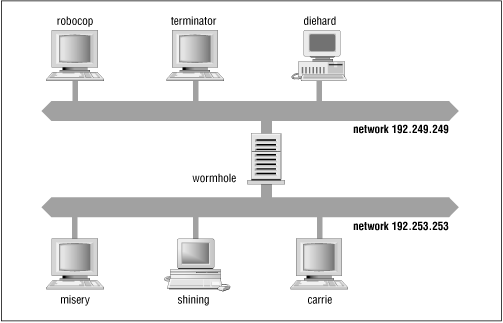4. Setting Up BIND
Contents:
Our Domain
Setting Up
DNS
Data
Setting Up a
BIND
Configuration File
Abbreviations
Host Name Checking (
BIND
4.9.4 and Later
Versions)
Tools
Running a Primary Master Name Server
Running a Slave Name Server
Adding More Domains
What Next?
"It seems very pretty," she said when she had finished it, "but it's rather hard to understand!" (You see she didn't like to confess, even to herself, that she couldn't make it out at all.) "Somehow it seems to fill my head with ideas - only I don't exactly know what they are!"
If you have been diligently reading each chapter of this book, you're probably anxious to get a name server running. This chapter is for you. Let's set up a couple of name servers. Others of you may have read the table of contents and skipped directly to this chapter. (Shame on you!) If you are one of those people who cut corners, be aware that we may use concepts from earlier chapters and expect you to understand them already.
There are several factors that influence how you should set up your name servers. The biggest factor is what sort of access you have to the Internet: complete access (e.g., you can ftp to ftp.uu.net ), limited access (limited by a security firewall), or no access at all. This chapter assumes you have complete access. We'll discuss the other cases in Chapter 15, Miscellaneous .
In this chapter, we'll set up two name servers for a fictitious domain, as an example for you to follow in setting up your own domain. We'll cover the topics in this chapter in enough detail to get your first two name servers running. Subsequent chapters will fill in the holes and go into greater depth. If you already have your name servers running, skim through this chapter to familiarize yourself with the terms we use or just to verify that you didn't miss something when you set up your servers.
4.1 Our Domain
Our fictitious domain is for a college. Movie University studies all aspects of the film industry and researches novel ways to distribute films. One of the most promising projects is research into using IP as the distribution medium. After talking with the folks at the Inter NIC , we have decided on the domain name movie.edu . A recent grant has enabled us to connect to the Internet.
Movie U. currently has two Ethernets, and they have plans for another network or two. The Ethernets have network numbers 192.249.249 and 192.253.253. A portion of their host table shows the following entries:
127.0.0.1 localhost # These are our killer machines 192.249.249.2 robocop.movie.edu robocop 192.249.249.3 terminator.movie.edu terminator bigt 192.249.249.4 diehard.movie.edu diehard dh # These machines are in horror(ible) shape and will be replaced # soon. 192.253.253.2 misery.movie.edu misery 192.253.253.3 shining.movie.edu shining 192.253.253.4 carrie.movie.edu carrie # A wormhole is a fictitious phenomenon that instantly transports # space travelers over long distances and is not known to be # stable. The only difference between wormholes and routers is # that routers don't transport packets as instantly--especially # ours. 192.249.249.1 wormhole.movie.edu wormhole wh wh249 192.253.253.1 wormhole.movie.edu wormhole wh wh253
And the network is pictured in Figure 4.1 .
Figure 4.1: The Movie University network





